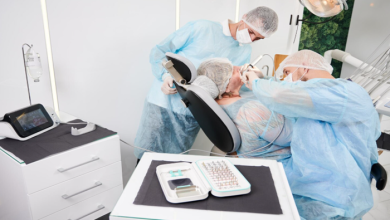
A healthy, confident smile says a lot about you. When dental issues affect your function and your confidence, full-mouth restoration can be a life-changing solution. This comprehensive dental treatment tackles multiple issues at once, restoring both your smile’s appearance and your oral health. Wondering if it’s right for you? This guide will walk you through the key considerations before moving forward with a full-mouth restoration.
Full-Mouth Restoration Explained
A full-mouth restoration (also called full-mouth reconstruction) is a tailored plan that rebuilds or replaces most or all of the teeth in your upper and lower jaws. It combines a range of restorative and cosmetic dental procedures to address significant dental challenges. The goal? To restore bite function, improve oral health, and give you a smile that looks natural and feels comfortable.
For those dealing with complex dental problems, a full-mouth restoration offers more than just cosmetic improvements. It can help with chewing, speaking, and prevent further dental issues down the line.
Why Might You Need Full-Mouth Restoration
Deciding to undergo full-mouth restoration is significant. Most people who opt for this treatment face advanced dental challenges, which can include:
Severe Tooth Decay
Untreated cavities can result in large areas of decay, sometimes making it impossible to save individual teeth with standard fillings or simple crowns.
Gum Disease
Advanced periodontal (gum) disease leads to tooth loss, bone loss, and widespread infection, affecting many or all of your teeth.
Injury or Trauma
Accidents, sports injuries, or falls can cause multiple teeth to break, be knocked out, or become damaged.
Worn Teeth
Chronic teeth grinding (bruxism) or acid erosion will gradually wear down enamel, leading to shortened and weakened teeth.
Congenital Conditions
Some people are born with developmental defects or genetic conditions, like amelogenesis imperfecta, that affect the form and function of the teeth.
If any of these sound familiar, you may be a candidate for full-mouth restoration.
Assessment and Initial Consultation
Starting your restoration process begins with a comprehensive dental evaluation. Here’s what to expect:
Detailed Diagnosis
Your dentist will carefully assess your oral health using digital X-rays, 3D scanning, and possibly CT imaging. They will check the health of your gums, bone structure, jaw alignment, and the aesthetics of your smile.
Treatment Planning
After gathering the data, your dentist will create a customized treatment plan. This plan outlines which procedures are needed, the ideal sequence, and the expected timeline. Your input matters at this stage. Be open about your goals, fears, and budget.
Second Opinions
If you’re at all uncertain, don’t hesitate to get a second opinion. Reputable dental professionals welcome this and can help confirm the right course of action.
Restorative Treatment Options
Every patient’s needs and goals are different, but common full-mouth restoration procedures include:
Dental Implants
All-on-X dental implants, such as those offered in Palm Harbor, FL, replace missing roots with titanium posts anchored in the jawbone and topped with realistic-looking crowns. They offer a long-term solution for missing teeth and help maintain bone health.
Crowns
Porcelain or ceramic crowns are used to cover and strengthen damaged, worn, or decayed teeth and restore their shape and function.
Bridges
A bridge replaces one or more missing teeth, anchored by the healthy teeth on either side. It restores your bite and keeps other teeth from shifting.
Dentures
Full or partial dentures might be used when several or all natural teeth are missing. Today’s dentures are more comfortable and lifelike than ever before.
Veneers
Thin porcelain veneers adhere to the front of existing teeth, improving esthetics and closing gaps or covering chips and stains.
Orthodontics
Straightening teeth with braces or clear aligners can be part of the restoration to ensure proper bite alignment.
Your full-mouth restoration plan may combine several of these treatments to achieve a balanced, healthy smile.
The Cost of Full-Mouth Restoration and Financing Solutions
Cost is one of the biggest concerns for most people. Because full-mouth restoration is highly personalized and can involve many procedures over several months (or more), prices vary widely. Factors include:
- The extent of dental work required
- Materials used (e.g., zirconia crowns vs. porcelain)
- Number of implants and restorations
- The dentist’s experience and location
A complete restoration can range from $15,000 for simpler cases to $50,000 or more for extensive, implant-heavy treatments.
Financing Your New Smile
Most dental practices understand the investment and offer payment plans or financing. Options may include:
- Third-party financing companies
- Phased treatment to spread costs over time
- Dental savings plans or membership discounts
Be sure to ask your provider about all available payment solutions, and verify what your dental or health insurance may partially cover.
What Recovery and Aftercare Look Like
Full-mouth restoration is often a staged process. Here’s what to expect during recovery and aftercare:
The Treatment Timeline
You may need several appointments spread over months, depending on healing times and the procedures performed (for example, implants require healing before crowns are placed).
Managing Discomfort
Some treatments involve minor oral surgery or tooth preparation, resulting in temporary swelling, soreness, or sensitivity. Dentists provide pain management strategies and aftercare instructions to keep you comfortable.
Temporary Restorations
You might wear temporary crowns, bridges, or dentures during certain phases to protect your teeth and maintain appearance.
Oral Hygiene
Meticulous home care is essential for successful, long-lasting results. Brush and floss diligently, and keep up with professional cleanings.
Long-Term Maintenance
Regular check-ups and adjustments keep your restored smile healthy. Some prosthetics (like dentures) may eventually need relining or replacement over time.
Picking the Right Dental Professional
Choosing who will guide you through full-mouth restoration is one of the most critical decisions you’ll make.
Credentials and Experience
Look for a dentist with advanced training in restorative and cosmetic procedures, ideally with membership in organizations.
Comfort and Trust
Communication matters. Choose someone who answers your questions, explains your options, and makes you feel comfortable every step of the way.
Technological Capabilities
Modern practices use digital scanners and design software for precision and comfort. Don’t be afraid to ask about the technology your dentist uses.
Conclusion
Opting for a full-mouth restoration is a big step, but it opens up a world of possibilities for your oral health, confidence, and overall well-being. Carefully consider the reasons for seeking treatment, work with a trusted dental professional, and stay consistent with your aftercare.




